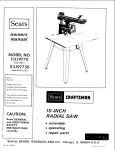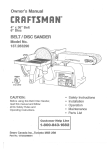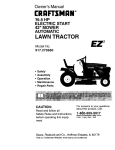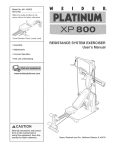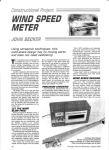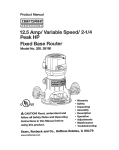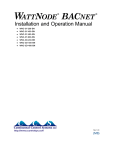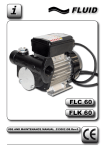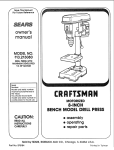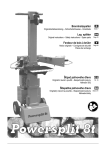Download Craftsman 320.10861 Operating instructions
Transcript
Owner's ManuaW Vlodel No. 320.10861 ,AUTtON. Read, understand and follow !1Safety Rules and Operating Instructions 1 this manual before using this product. o SAFETY o ASSEMBLY o OPERATION ,' MAINTENANCE • ESPAI_iOL ;ears, Roebuck and Co., Hoffman Estates, nL60179 U.S.A. Warranty ................................................... Page Safety Instructions ......................................... Pages 2 3-11 Safety Symbols ............................................ Page 11 Assembly ......... Description ........ Operation ......... Maintenance ...... Accessories ....... Service Numbers. ....................... Pages ....................... ....................... Pages Pages 12-13 13-14 15-23 ........................ Page 24 ....................... Page 25 .................................... FULL ONE YEAR WARRANTY ON CRAFTSMAN Back cover CIRCULAR SAW If this product fails due to a defect in material or' workmanship within two years from the date of purchase, RETURN IT TO THE NEAREST SEARS STORE IN CANADA, and Sears will replace it, free of charge. This warranty gives you specific legal rights, and you may also have other rights which vary from province to province. Sears, Roebuck and Co., Dept. 817 WA, Hoffman Estates, IL 60179 ,_ .... SAVETHESE iNSTRUCTIONS! READ ALL iNSTRUCTIONS! 2 wlnrwm ...................................... I" ,i ! WARNING: | instructions F _. . = .1..1 listed .1.1.1 1.1 .... SAFETY BE SURE to read and understand below may result in electric H........................... shock, all instructions, fire and/or = 111.. PRECAUTIONS Failure _ serious to follow all H..=,., H. personal injury,. W =..Hi=. FOR LASER This saw has a built-in laser light° The laser is a Class Ilia and emits output power of a maximum 2,,5mW and 400nm * 700nm wavelengths,, These lasers do not normally present an optical hazard. However, DO NOT stare at the beam because it can cause flash blindness, IMPORTANT: The following label is on your saw. it indicates where the laser light is emitted by the saw. ALWAYS BE AWARE of its location when using the saw and ALWAYS MAKE SURE that any bystanders in the vicinity of use are made aware of the dangers of looking directly into the laser. AVOID EXPOSURE LASER RADIATION EMITTED FROM THIS APERTURE m == ....=, , i WARNING: Stare into beam, LASER LIGHT. LASER RADIATION Avoid Direct Eye Exposure° Only turn laser beam on when tool is on the workpiece. Class Ilia. WARNING: deliberately stare using this saw° ................... DO NOT stare directly into the beam ALWAYS = . ,,=,,',, Do Not at the laser beam,, A hazard may exist if you follow the following safety precautions when .m.r.=.... 1..., 1. The tinted glasses that were included will enhance the laser light in bright light conditions, DO NOT wear these glasses if they interfere with the safe operation of this saw. Z. NEVER aim the beam at any person or object other than the workpieceo ]. The laser beam can be harmful to the eyes, ALWAYS avoid direct eye exposure. DO NOT look directly into the faser beam output aperture during operation,. _. The laser on the saw is not a toy., ALWAYS keep out of the reach of children. The laser light emitted from this device SHOULD NEVER be directed towards any person, for any reason,. _. ALWAYS be sure the laser beam is aimed at a sturdy workpiece coated surfaces) that does not have a reflective surface (such as wood or rough SAFETY PRECAUTIONS FOR LASER cont. 6, DO NOT use on surfaces such as sheet steel that have a shiny, reflective surface. The shiny surface could reflect the beam back at the operator. 7. ALWAYS reflective be aware that laser light reflected surfaces can also be dangerous° J,_,,,_,J = I , ..... off of a mirror or any other ............................. ,,., CAUTION: ALWAYS follow only the instructions contained in this manuat when using this laser, Use of this feature in any manner other than what appears in this manual may result in a hazardous radiation exposure _ ,un ............ 8. DO NOT attempt to modify the performance of this laser device in any way° This may result in a dangerous exposure to laser radiation. 9. For further information regarding lasers, refer to ANSI - Zt36.1 The STANDARD FOR THE SAFE USE OF LASERS, available Laser Institute of America (407) 380-1553. WORK from the AREA SAFETY 1. ALWAYS keep your work invite accidents.. area clean and well lit. Cluttered benches and dark areas 2. DO NOT operate power tools in explosive atmospheres, such as in the presence of flammable liquids, gases, or dust. Power tools create sparks which may ignite the dust or fumes. 3. ALWAYS keep bystanders, children, and visitors Distractions carl cause you to lose control. ELECTRICAL away while operating a power tool. SAFETY 1. Double insulated tools are equipped with a polarized plug (one blade is wider than the other_)This plug will fit in a polarized outlet only one way. If the plug does not fit fully in the outlet, reverse the plug. If it still does not fit, contact a qualified electrician to install a polarized outlet. Do not change the plug in any way. 2. Double insulation _ eliminates the need for the three-wire grounded power cord and grounded power supply system. Applicable only to Class tl (double insulated) tools. 3. Before plugging in the tool, BE SURE that the outlet voltage supplied is within the voltage marked on the tool's data plate. DO NOT use "AC only" rated tools with a DC power supply° 4. ALWAYS avoid body contact with grounded surfaces, such as pipes, radiators, ranges and refrigerators. There is an increased risk of electric shock if your body is grounded. ELECTRICAL SAFETY cont. 5. If operating the power tool in damp locations is unavoidable, ALWAYS use a Ground Fault Circuit interrupter to supply power to your tool. ALWAYS wear electrician's rubber gloves and footwear in damp conditions. 6. DO NOT expose power tools to rain or wet conditions. will increase the risk of electric shock° Water entering a power tool 7. DO NOT abuse the cord. NEVER use the cord to carry the tools or pull the plug from the outlet. Keep cord away from heat, oil, sharp edges or moving parts_ Replace damaged cords immediately. Damaged cords increase the risk of electric shock_ 8. When operating a power tool outside, ALWAYS use an outdoor extension cord marked "W-A" or"W". These cords are rated for outdoor use and reduce the risk of electric shock° NOTE: The extension efficient use Smaller than 18 gauge wire). PERSONAL cord must have adequate wire size AWG (American Wire Gauge) for safe, gauge wires, have greater capacity (I6 gauge wire has more capacity SAFETY 1. ALWAYS stay alert, watch what you are doing and use common sense when operating a power tool. DO NOT use tool while tired or under the influence of drugs, alcohol, or medication. A moment of inattention while operating power tools may result in serious personal injury 2. ALWAYS dress properly. DO NOT wear loose clothing or jewelry. Keep your hair, clothing, and gloves away from moving parts. Loose clothes, jewelry, or long hair can be caught in moving parts° Pull back tong hair. PERSONAL SAFETY cont. 3. ALWAYS avoid accidental starting. BE SURE switch is in the "Off" position before plugging in. DO NOT carry tools with your finger on the switch, Carrying tools with your finger on the switch or plugging in tools that have the switch in the "On" position invites accidents. 4, ALWAYS remove adjusting or a key that is left attached keys or wrenches before turning the tool "On". A wrench to a rotating part of the tool may result in personal injury, 5. DO NOT overreach, ALWAYS keep proper footing and balance at all times. Proper footing and balance enables better control of the tool in unexpected situations. 6. ALWAYS use safety TOOL USE AND CARE equipment, Always wear eye protection, SAFETY 1. ALWAYS use clamps or other practical ways to secure to a stable platform, Holding the work by hand or against lead to loss of control. and support the workpiece your body is unstable and may 2. DO NOT force tool. Use the correct tool and blade for your application. The correct tool and blade will do the job better and safer at the rate for which it is designed, 3. DO NOT use tool if switch does not turn it "On" or "Off". Any tool that cannot controlled with the switch is dangerous and must be repaired° be 4, ALWAYS disconnect the plug from the power source before making any adjustments, changing accessories,or storing the tool, Such preventive safety measures reduce the risk of starting the tool accidentally° 5. ALWAYS store idle tools out of reach of children and other Tools are dangerous in the hands of untrained users. untrained persons, 6. ALWAYS maintain tools with care. Keep cutting tools sharp and clean, Properly maintained tools with sharp cutting edges are tess likely to bind and are easier to control. 7. ALWAYS check for misalignment or binding of moving parts, breakage of parts, and any other condition that may affect the tool's operation. If damaged, have the tool serviced before using. Many accidents are caused by poorly maintained toots= 6 TOOL USE AND CARE SAFETY ,i,,11 I i cont. ........ WARNING: USEOF ACCESSORIES THATARE NOTRECOMMENDEDFORUSE A HAZARDOUS CONDITION_ W1T,H THIS TOOL MAY,,CREATE 8. ALWAYS use only accessories that are recommended for this tool. Accessories be suitable for one tool may become hazardous when used on another tooL SERVICE that may SAFETY 1. If any part of this saw is missing or should break,bend, or fail in any way; or should any electrical component fail to perform properly: ALWAYS shut off the power switch and remove the saw plug from the power source and have the missing, damaged or failed part replaced BEFORE resuming operation_ 2. Tool service must be performed only at a Sears Service Center. performed by unqualified personnel could result in a risk of injury SAFETY RULES FOR CIRCULAR Service or maintenance SAWS on the auxiliary handle or motor housing, if both hands are hotding the saw, they cannot be cutDANGER! bv the. blade Keep hands away from cutting area and blade. Keep your second hand 1. ALWAYS keep your body positioned to either side of the saw blade, but not in line with the saw blade. Kickback could cause the saw to jump backwards (See Kickbacko.. What Causes It and Ways to Prevent It on pages 8-9) 2. DO NOT reach underneath beneath the work the work. The guard cannot protect you from the bfade 3. ALWAYS check lower guard for proper closing BEFORE each use. DO NOT operate the saw if the lower guard does not move freely and close instantly. Never clamp or tie the lower guard in the open position. If the saw is accidentally dropped, the lower guard may be benL Raise the lower guard with the retracting handler Make sure that it moves freely and does not touch the blade or any other part in all angles and depths of cut. 4. ALWAYS check the operation and condition of the lower guard spring. If the guard and the spring are not operating properly, they MUST be serviced before use. The lower guard may operate sluggishly, due to damaged parts, gummy deposits, or a buildup of debris_ 5. The lower guard should be retracted manually ONLY for making special cuts, such as pocket or compound cuts. ALWAYS raise the lower guard by retracting the handle. As soon as the blade enters the material, the lower guard MUST be released. For alt other sawing, the tower guard should operate automatically. 6. ALWAYS make sure that the lower guard is covering the blade BEFORE placing the saw down on a work bench or floor. An unprotected moving blade will cause the saw to walk backwards, cutting whatever is in its path Make note of the time it takes for the blade to stop spinning after the switch is released I SAFETY RULES FOR CIRCULAR SAWS cont. 7. NEVER hold the piece being cut in your hands or across your legs. It is important to support the work properly in order to minimize body exposure, blade binding, or loss of control. 8. ALWAYS hold tool by insulated gripping surfaces when performing an operation where the cuttingtool may contact hidden wiring or its own cord. Contact with a "live" wire will make the exposed metal parts of the tool "live" and shock the operator 9.When ripping, ALWAYS use a rip fence or straight edge guide. This improves the accuracy of the cut and reduces the chance of the blade binding. 10. ALWAYS use blades that have the correct size and shape (diamond vs. round) arbor holes. Blades that do not match the mounting hardware of the saw will run erratically and will cause loss of control° 11. ALWAYS BE SURE that all adjusting screws and the blade holder are fastened tightly BEFORE making a cut. Loose adjusting screws and holders can cause the tool or blade to slip and loss of control may result. 12. When removing the blade from the tool, ALWAYS avoid contact with skin and ALWAYS wear protective gloves when grasping the blade or accessory. Accessories may be hot after prolonged user KICKBACKo..WHAT The Causes CAUSES IT AND WAYS TO PREVENT IT of Kickback 1. Kickback is a sudden reaction to a pinched, bound or misaligned saw blade, which causes the uncontrolled saw to lift up and out of the workpiece and towards the operator 2. When the blade is pinched or bound tightly by the kerf closing down, the blade stalls and the motor reaction drives the unit rapidly back towards the operator. 3. If the blade becomes twisted or misaligned in the cut, the teeth at the back edge of the blade can dig into the to_ surface of the wood_ This causes the blade to climb out of the kerr and jump back towards the operator. 4. Kickback is a result of tool misuse and/or incorrect operating procedures or conditions. It can be avoided by taking the proper precautions, as listed on next page° Ways to Prevent Kickback 1. ALWAYS maintain a firm grip with both hands arms to allow you to resist KICKBACK forces. operator, if the proper precautions are taken. on the saw and position your body and KICKBACK forces can be controlled by the 2. If the blade is binding, or when you are interrupting a cut for any reason, ALWAYS release the trigger and hold the saw motionless in the material until the blade comes to a complete stop. NEVER attempt to remove the saw from the work or pull the saw backward while the blade is in motion or KICKBACK may occur. ALWAYS check and be ready to take corrective action to eliminate the cause of blade binding° 3.When restarting the saw in the workpiece, ALWAYS center the blade in the kerf and check to be sure that the saw teeth are not engaged into the material. If the saw blade is binding, it may walk up or KICKBACK from the workpiece when the saw is restarted. 4. ALWAYS support large panels to minimize the risk of blade pinching and KICKBACK. Large panels tend to sag under their own weight. Supports MUST be placed under the panel on both sides, near the line of cut and near the edge of the panel,, 5. DO NOT use a dull or damaged blade. Unsharpened or improperly set blades produce narrow kerr which causes excessive friction, blade bindingand KICKBACK. 6. ALWAYS be sure that the blade depth and adjusting locking levers are tight and secure BEFORE making a cut. If blade adjustment shifts while cutting, it may cause binding and KICKBACK. 7. ALWAYS use extra caution when making a "Pocket Cut" into existing walls or other blind areas. The protruding blade may cut objects that can cause KICKBACK. 8. ALWAYS have saw blade at full speed before contacting workpiece, 9. ALWAYS hold tool by insulated gripping surfaces when performing an operation where the cutting tool may contact hidden wiring or its own cord. Contact with a "live" wire wilt make the exposed metal parts of the tool "live" and shock the operator. IMPORTANT: See Operation avoiding Kickback, Section of this Manual for additional instructions for ADDITIONAL RULES FOR SAFE OPERATION s WARNING: ............. instructions.., BE SURE to read and understand listed below may result in electric all instructions. shock, fire andlor Failure to follow serious personal 1. Know your power tool. Read operator's manual carefully. Learn the applications limitations, as well as the specific potential hazards related to this tool. 2. ALWAYS wear safety glasses or eye shields when using this saw. Everyday have only impact-resistant lenses; they are NOT safety glasses. 3. ALWAYS protect 4. ALWAYS protect operation. your lungs. Wear a face mask or dust mask if the operation your hearing. Wear hearing protection during extended all injury. and eyeglasses is dusty. periods of 5. ALWAYS inspect the tool cords periodically and if damaged have them repaired at your nearest Sears Service Center or other Authorized Service Facility. ALWAYS be aware of the cord location. 6. ALWAYS check for damaged parts. Before further use of the tool, a guard or other part that is damaged should be carefully checked to determine if it will operate properly and perform its intended function. Check for misalignment or binding of moving parts, breakage of parts, and any other condition that may affect the tool's operation. A guard or other part that is damaged, should be properly repaired or replaced at a Sears Service Center. 7. DO NO]" abuse the cord. NEVER use the cord to carry the tool or pull the plug from the outlet. Keep cord away from heat, oil, sharp edges or moving parts. Replace damaged cords immediately. Damaged cords increase the risk of electric shock. 8. ALWAYS make sure that your extension cord is in good condition.When using an extension cord be sure to use one that is heavy enough to carry the current that your tool will draw. A wire gauge (AWG) of at least 14 is recommended for an extension cord 25 feet or less in length, When working outdoors ALWAYS use an extension cord that is suitable for outdoor use The cord's jacket will be marked WA. Smaller gauge wires, have greater capacity (16 gauge wire has more capacity than 18 gauge wire). An undersized cord will cause a drop in line voltage, resulting in loss of power and overheating. 10 ! ADDITIONAL 9. ALWAYS RULES inspect FOR SAFE and remove OPERATION cont. all nails from lumber 10. DO NOT use the too! while tired medication. or under before sawing. the influence of drugs, alcohol or any 11. SAVE THESE INSTRUCTIONS. Refer to them frequently and use them to instruct who may use this tool. If someone borrows this tool, make sure they have these instructions also. i....... WEAR YOUR i i, ,11 WARNING: others ...................... The operation of any circular saw can result in foreign objects being thrown into your eyes, which can result in severe eye damage. Before beginning power tool operation, ALWAYS wear safety goggles or safety glasses with side shield and a full face shield when needed_ We recommend A Wide Vision Safety Mask for use over eyeglasses or standard safety glasses with side shield, available at Sears Retai! Stores. ' L,I,I WARNING: Some .................... dust particles created i i,,, ,,i, by power sanding, sawing, grinding, drilling and other construction jobs contains chemicals known to cause cancer, defects or other reproductiveharm. Some examples of these chemicals are: • Lead from lead-based paints. • Crystalline silica from bricks and cement and other masonry products° • Arsenic and chromium from chemically-treated lumber., Your risk from these exposures varies, depending upon how often you do this type of work° To reduce your exposure to these chemicals: • Work in a well-ventilated area. - Work with approved safety equipment, such as those dust masks that are specially designed to filter out microscopic particles.. ............. IIH, ,,,i,i1,11,1 ,, , ,i ,11111 I'"M The label on your tool may include the following V ..................................................................... Volts symbols. A ................................................................. Amperes Hz ...................................................................... Hertz W ..................................................................... Watts rain ................................................................... Minutes .....,.................................................................... Alternating current ............................................................. Direct current no .................................................................... No-load speed . [] ............................................................................ Class ii construction ..fmin ....................................................... Revolutions or Strokes per minute ................................................................... indicates danger, warning or caution, It means attention! Your safety is involved.. IMPORTANT! READ ALL INSTRUCTIONS 11 birth UNPACKING Your circular saw has been shipped completely assembled. Inspect the saw carefully sure that no breakage or damage has occurred during shipping. If any parts are damaged or missing return the saw to your nearest Sears Store to have it replaced. to make Z_,f_'ARNgNG. " If any parts are missing, DO NOT operate this saw until the missing are replaced. Failure to do so could result in possible serious personal injury,, ,,,ml,=,,,=,, MOUNTING parts ,!=,=== ,,, ,1,,1,,11 THE BLADE TO SAW Carefully remove the blade from its packing sure that it is not cracked or damaged. and thoroughly inspect it to be z_W,&RNING: Your saw should NEVER be connected to the power source when you are assembling parts, making adjustments, installing or removing blades, cleaning or when it is not in use.Disconnecting the saw will prevent accidental starting, that could cause serious personal injury, _WA, RNING: A 7 1/4-inch blade is the maximum blade capacity than 7 1/4-inch blade will come in contact with the blade guards. Also, that is so thick that it prevents the outer blade washer from engaging spindle. Blades that are too large or too thick can result in an accident personal injury. of your saw,, A larger NEVER use a blade with the flat side of the causing serious Your saw has a spindle lock button for locking the spindle on your saw in a stationary position. Push and hold the spindle lock button when mounting, changing or removing the blade. 1. Remove blade wrench from base. 2. Place saw on its side on a flat surface,, 3. Firmly hold down spindle lock button, and use blade wrench to loosen blade screw by turning it in a counterclockwise direction. Completely remove blade screw (See Fig. 1). 4. Remove outer "D" washer (See Fig. 1 ). 5. The part remaining is the inner bushing (See Fig,, 1), It does not need to be removed. 6. Wipe a drop of oil onto the inner bushing and outer "D" washer where they will touch blade. 7. Place the saw blade inside the lower blade guard, onto the spindle and against the inner bushing (See Fig. 1), NOTE; The teeth of the blade should point upward at the front of the saw as shown in Fig° 1, 8. Place saw on the edge of a flat surface so the blade is not in contact with anything. 9. Raise lower blade guard using the blade guard handle and hold it in the raised position for the next steps, 12 ! MOUNTING THE BLADE TO SAW cont. '10. Replace the "D" washer (See Fig° 1). inner Fig. 1 Bushing 11. Firmly hold down spindle lock button as you replace blade screw and hand Blade Outer"D" Washer tighten it in a clockwise direction Screw Spindle (See Fig, 1), Then use blade wrench to tighten blade screw thoroughly. 12. Place blade wrench back in base. NOTE: Always IMPORTANT: engage 1. Unplug I NEVER of blade wrench upwards,, use a blade that is too thick to allow the "D" washer to with the flat side of the spindle, REMOVING , ,,, place angled portion THE BLADE the saw. 1,, 1, '=M,IH WARNING: 11"'"',', ,'1 = Failure to unplug the saw could result in accidental starting= 111 causing , ,11mlrl,, possible serious ........ personal injury = M"H=" ............... I I ",, 2. Raise the lower blade guard using the guard handle, hold down the spindle lock button. 3. Follow Steps 1 through lock button, 4. Carefully 4 on Mounting Blade to Saw, but DO NOT hold down the spindle remove blade. KNOW YOUR SAW (See Fig, 2 ) Your circular saw has many built-in convenience features for fast, efficient cutting:These features include the laser beam that projects a line of light along the cutting line for accurate cutting It also has easy-to-operate adjustments for depth-of-cut and bevel cutting. Electrical Connection Your circular saw has a precision-built electric motor and it should only be connected to a 120wolt, 60-Hz_ power supply (normal household current). DO NOT operate on direct current (DC)o This large voltage drop will cause a loss of power that will overheat the motor, If your saw does not operate when plugged into an outlet, check the power supply, Trigger Switch To turn on the saw, squeeze shut saw off. the trigger switch. When you have finished 13 sawing, release switch to Fig. 2 ght On/Off Button Trigg Asist Handle Rear Handle Light Aperture Upper Blade Guard evel Scale Lower Blade Guard Handle Base Adjustment Knob Depth-Of-Cut Scale Lower Blade Gua Blade Trig Spindle Lock Button De ustment _b t Tighten Input Blade Diameter 13 Amps Blade Arbor 5/8-in. (16 ram) ...... Cutting Depth at 900 23/8,,,in. 60.33 ram), Cutting Depth at 45 Maximum Bevel Angle 113116in. (46m m) 54.50 Rating 120 volt& 60 Hz AC No Load Speed 500O RPM 7 1/4in. (184 ram) 14 .............. _l, rl, i, CAUTION: a careless..... i fraction ........ ii i,l-i ...... i,, , i i,i.... DO NOT let familiarity with your saw make you careless. of a second is sufficient to cause severe injury° ......... i i i ..................... Before attempting to use any tool, be sure to familiarize and safety instructions. Using ,,,,,i,l,i ....... yourself ii Remember with all the operating that ! features the Laser Light Feature (see Figs, 3 & 4) Lpe!son ARNING: '..................................... Do NOT stare directly at the laser beam. NEVER aim the light at any or object other than the workpiece. I, The tinted glasses that were light in bright light conditions° if they interfere with the safe 2, DO NOT turn the laser beam included will enhance the laser DO NOT wear these glasses operation of this saw. on until the saw is on the workpiece. 3, Mark the line of cut on the workpieceo 4, Adjust the cutting angle and cutting depth as needed. 5. Plug in the saw and push button to turn on laser. (See Fig. 3)° 6, Align laser beam with tine-of-cut (See Fig. 4). 7, Squeeze the trigger switch and slowly push the saw forward using both hands. Keep the red laser light beam on the line-of-cuto 8, ALWAYS shut off the laser light when you have finished cutting. 15 Laser Button i SAW BLADES All saw blades need to be kept clean, sharp and properly set in order to cut efficiently° Using a dull blade places a heavy toad on the saw and increases the danger of kickback., Keep extra blades on hand, so sharp blades are always available. Gum and wood pitch hardened on the blade slows the saw down, Use gum and pitch remover, hot water or kerosene to remove them. DO NOT use gasoline° BLADE GUARD SYSTEM The lower blade guard, attached to your circular saw, is there for your protection and safety. It should NEVER be altered for any reason. If it becomes damaged or begins to return slowly or sluggishly, DO NOT operate your saw until the damage has been repaired or replaced. ALWAYS leave the guard in its correct operating position when using the saw. i DANGER: When sawing through i a workpiece, ....... i the lower blade guard does not cover the blade on the underside of the workpiece (see Fig_ 5)° Since the blade is exposed on the underside of the workpiece, ALWAYS keep your' hands and fingers away from the cutting area, Any part of your body coming in contact with the moving blade will result in serious injury. l!l, ....... i,, i ,,i,,,,,i,ii, i, ,11 , ,,11,,,,i, ii1,11 i , ii1,, ,, n .............................. ,Hil,,i,lU, CAUTION: NEVER use the saw when the guard is not operating properly. The guard should be checked for correct operation before each use. if you drop your saw, check the lower blade guard and bumper for damage at all depth settings before using. NOTE: The guard is operating properly when it moves freely and then readily returns to the closed position, If, for any reason, your lower blade guard does not close freely, take it to your nearest Sears Repair Center' for service before using ito i,,, i, i IHI'I'"'L"J ................... Fig. 5 Lower Blade Guard is in UP Position When Making a Cut _ "-'-'_""'---_----- Blade 1/4-in_ or less is Exposed on Underside 16 of Workpiece KICKBACK Kickback occurs when the blade stalls rapidly and the saw is driven back towards stalling is caused by any action which pinches the blade in the wood IMPORTANT: .. ! saw I The best guard ,,, staIIs Kickback DANGER: !,, to serio,,us irljury_ against kickback is Caused HI, iiii "'Nm'""l '' I'"'nnr im Blade is Set Too Deep By: Blade Depth Setting (See Fig 6 and 7)° 4. Making a cut with a dull, gummed or improperly set blade 5. Not providing proper support for workpiece (See Fig, 8) 6. Forcing a cut. 7. Cutting warped or wet lumber, 8. Tool misuse or incorrect operating 9. Contacting the workpiece at less than full speed, the Chance Fig. 7 up, Wrong procedures, with blade of Kickback: 1. ALWAYS use the correct blade depth setting, The correct blade depth setting for all cuts should not be more than 1/4-inch below the material to be cut (see Fig, 8), 17 I ...... Depth 2. Sawing into knots or nails in the workpiece, 3. Twisting the blade while making a cut. To Lessen practices. could cause you to lose control of the saw, Loss of control can lead ALWAYS release trigger switch immediately if the blade binds or the , ..................................... Correct Kickback dangerous , i 1. Incorrect is to avoid ,Hml ................. you, Blade To Lessen 2. ALWAYS BEFORE the Chance of Kickback: cont. inspect the workpiece for knots or nails beginning to cuL NEVER saw into a knot or nail. 3. Make straight cuts. ALWAYS use a straight edge guide when rip cutting This wil! help prevent twisting the blade in the cut° This will help prevent twisting the blade in the cut 4. ALWAYS use clean, sharp and properly set blades. NEVER make cuts with dull blades° 5. ALWAYS properly support the workpiece before beginning a cut° This witt help you avoid pinching the blade The right and wrong ways to support large workpieces are shown in Figures 8 and 9. 6. ALWAYS use steady, even pressure when making a cut° NEVER force the cuL 7. DO NOT cut wet or warped Correct Blade Depth Se_ng = Blade Exposed 1/4-in,. or less on underside of workpiece Fig,9 lumber. 8. ALWAYS hold the saw firmly with both hands and keep your body in a balanced position. This will hetp you resist the force of kickback, should it occur. IMPORTANT: When using your saw, ALWAYS stay alert and exercise control° DO NOT remove your saw from the workpiece, while the blade is moving. DEPTH-OF-CUT ADJUSTMENT ALWAYS use the correct blade depth setting, The correct blade depth setting for all cuts should not be more than 1/4-inch below the material being cut. Allowing more depth will increase the chance of kickback and cause the cut to be rough. Your saw is equipped with a depth-of-cut scale on the upper blade guard that will provide increased depth-of-cut accuracy (See Fig. 10). Fig. 10 Depth-Of-Cut Depth-Of-Cut Scale Adjusting Bracket Base _ Raise the Saw Lower the Saw 18 Scale TO ADJUST BLADE DEPTH 1. Unplug the saw. I ......................................... ..................... -I WARNING: possible serious Failure to unplug the saw could result in accidental personal injury. , u ,i.................... starting causing n,u ...................... 2, Raise depth adjust lever to loosen,, (See Fig, 10), 3. Determine the desired depth of cut° 4o Locate the depth_of-cut scale on the back of the upper blade guard 5. Hold the base of the saw flat against the edge of workpiece and then raise or lower the saw until the indicator mark on the bracket aligns with the notch on the blade guard° 6, Tighten depth adjust lever, STARTING A CUT 1. ALWAYS use your saw with your hands .....M, I I ...... I positioned correctly (See Fig° ! 1), ......................................... easier,, ,t_ WAR LossNING of control : ALWAYS of the saw maintair] could proper cause an control accident of the resulting saw to ii ,,,,,n,,ll, NEVER use the saw with your shown in Fig. 12! TO HELP MAINTAIN 1, ALWAYS hands positioned as CONTROL support the workpiece near the cut. 2. ALWAYS support on your right,, the workpiece so the cut will be 3. ALWAYS clamp the workpiece so it will not move during the cut° Place the workpiece with the good side down, NOTE: The good side is the side where appearance is important° Before starting a cut, draw a guideline along the desired line of cut. Then place the front edge of the saw base on that part of the workpiece, that is solidly supported (See Fig. 11)_ 4.NEVER place the saw on the part of the workpiece will fall off when the cut is made° 5.ALWAYS keep the cord away from the cutting area, ALWAYS place the cord so it does not hang up on the workpiece when making a cut 119 that in possible sawing make i ,u serious safer injury. and ! i TO HELP MAINTAIN CONTROL cont. = .................. ==!===,==,,,= ,,,,,,=,=...... immediately° Z_ WARNUNG: To avoid If injury the cord unplug hangs the up saw on and the workpiece move the cord during to prevent a cut_ re,ease it from thehanging trigger upswitchagain° I it,,, i....... iii, ,i ,11, i, =,,,,i,l,,= ...... I ,i,.i, , I, I [ =,,,=,,,H .... ,u, the sawhave with itareplaced damaged before cord could in serious If the DANGER: cord has beenUsing damaged, using result the saw again_ injury or death° " u,uunu,,,,n 6. Hold the saw firmly with both hands (See Fig. 13), 7. Squeeze the trigger switch to start the saw. ALWAYS let the blade reach full speed before you begin the cut into the workpiece. ,,i, , u m ! Fig. 13 8. When making a cut, ALWAYS use steady, even pressure Forcing the saw causes rough cuts and could shorten the life of the saw or cause kickback. 9, After completing your cut, release the trigger switch and allow the blade to come to a complete stop° DO NOT remove the saw from the workpiece while the blade is moving.. DANGER: When sawing through the workpiece, the lower blade guard does not cover the blade.The blade is exposed on the under side of the workpiece. ALWAYS your hands and fingers away from the cutting area. Any part of your body coming contact with the moving blade will result in serious injury. I I keep in m ....... ,,n ==,=,1 n,,,,n, CAUTION: Whenever you lift your saw from the workpiece, the blade is exposed on the under side of the saw until the lower blade guard closes. ALWAYS MAKE SURE that the lower blade guard is closed before setting the saw down on work surface. t, WARNING: it could cause ,=m If the blade comes the saw to kickback ,....................... i,i1,1,111111,,i,, I in contact with the workpiece towards you, resulting nm,n uu, = 2O in serious before it reaches ful! speed, injury ,1,,'1 .......... MAKING CROSS 1 ilulr. CUTS OR RIP CUTS 1. When making cross or rip cuts, align your iine of cut with the outer blade guide notch on the base of the saw (See Fig° 14). 2. Since blade thicknesses vary, ALWAYS make a trial cut in scrap material along the guideline to determine how much, if any, the guideline must be offset to get an accurate cut. Fig, 14 U0h: I/ Align Outer Blade on Saw Base with (as shown) When Cuts or Rip Cuts MAKING BEVEL on line of cut Guide Notch Line of Cut Making Cross CUTS 1. Your saw can be adjusted to cut at any angle between 0 ° and 54,5°° When making 45 ° bevel cuts, there is a notch in the saw base to help you line up the blade with the line of cut (See Fig° t5). 2. Align your line of cut with the inner blade guide notch on the base of the saw when making 45 ° bevel cuts. 3. Since blade thicknesses vary and different angles require different settings, ALWAYS make a trial cut in scrap materials along a guideline to determine how much you should offset the blade from the guideline to make an accurate cuL Align Inner Blade Guide Notch on Base with Line of Cut (as shown) When Making 45 ° Bevel Cuts , ,,,,i.i. I,I,H,,.,. 4, When making a bevel cut ALWAYS hotd your saw firmly with both hands (See Fig,, 16). 5, Rest the front edge of the base on the workpiece, Then squeeze the trigger switch to start the saw. ALWAYS let the blade reach full speed, then guide the saw into the workpiece. 6. After completing your cut, release the trigger switch and allow the blade to come to a complete stop° DO NOT remove the saw from the workpiece while the blade is moving° .......................... I' I,ul , I .................... II1",1'111 I .................... D ! speed, _.k W.at, it could RN_NQ: causeif the saw bladetocomes kickback in contact towards with you,the resulting workpiece in serious before injury. it reaches ,_ i u,,i i,i...... 21 full II TO ADJUST THE BEVEL SETTING 1. Unplug the saw _ i WARNSNG: possible serious Failure to unplug the saw could result in accidental personal 2. Loosen bevel adjustment 3. Raise the motor housing scale (See Fig 17), 4. Tighten starting causing I injury, I knob (See Fig, 17) end of the saw until you reach the desired angle setting on the bevel Knob securely I lresult _ WARN'NG"in serious injury, Attempting a bevel cut with°ut the kn°b being securely POSITIVE 0 ° BEVEL STOP (See Fig. 17) Your saw has a positive 0 ° bevel stop, it was adjusted at the factory blade for 90 ° cuts. However, shipping can cause misalignment. tightened can to assure 0 ° angle of the saw To Check 1. Unplug the saw, ! Z_ WARNING: Failure to unplug the saw could result in accidental LPossible serious personal injury. square causing ! , 2. Place saw in an upside down position 3. Use a carpenter's starting on workbench to check the squareness J (See Fig, 17)o of the saw blade to the base on your saw, Fig. 17 Bevel S_ate Cqarpenter's uare To Adjust 1. Unplug the saw,, /_ WARNING: possible 2. Loosen 3. Loosen serious Failure to unplug the saw could result in accidental starting personal injury. ,, , bevel adjustment hex nut securing _ i can result in I i knob knob, adjustment screw., 4. Turn screw and adjust base until square 5. Tighten causing with saw blade, hex nut and knob securely. WARNING: Attempting to make cuts without I seri°us !nJur; knob securely tightened nllllm,un 22 i,n ,,, n i i ! TO MAKE POCKET CUTS zero ! Artier setting can result in a loss of contro_ d the saw, possibly ! caus,ng serious in:.ury. . i _ ! 1. Adjust the bevel setting to zero, set the blade to the correct blade depth setting, and use the lower blade guard handle to swing the guard up. ,, ............. ,, rr,ii " ,i,l,,,imn . I i Z_ WARNING: to avoldl serious ALWAYS injury,, ..... iii.............. raise the tower blade guard with the handle 1 .................... ,......................................... 2. White holding the tower blade guard by the handle, firmly rest the front of the base flat against the workpiece with the rear handle raised so the blade does not touch the workpiece (See Fig,, 18),, 3. Squeeze the trigger switch to start the saw_ ALWAYS let the blade reach full speed, then slowly lower the blade onto the workpiece until the base is flat against the workpiece. 4. After you complete the cut, release the trigger switch and allow the blade to come to a complete sto F After the blade has stopped, remove it from the workpiece. If the corners of your pocket cut are not completely cut through, use a hand saw or sabre saw to finish. - _ Ii Leaving Z_ WARNING: the blade ................................................ i ,,i NEVER could tie theresult lower inblade guard in the raised position., exposed serious injury.. ........... nl i,,,i, .................. MAKING RIP CUTS ALWAYS use a guide when making tong or wide rip cuts with your saw,. Using a Straight Edge You can make an efficient rip guide by clamping edge to your workpiece (See Fig19) a straight 1. Secure the workpiece_ 2. Use C_ctamps to firmly attach straight edge to the workpiece_ 3. Carefully guide the saw along the straight edge for a straight rip cut 4. DO NOT bind the blade in the cut. 23 ,, i,,i , !,it I SERVICE i= ........ 1,,,1 .... WARNING: Preventive result in misplacing hazard. WARNING: BEFORE t,j i, cleaning ill ii,,i , n .... maintenance of internal = performed wires and components, .................................. =u , ,,,_, by unauthorized which To avoid accidents, ALWAYS disconnect or performing any maintenance, .... u could personnel cause ..... may a serious the tool from the power source i,,, ,i, i,i ,i o All service that requires opening the saw MUST only be performed by a Sears Service Center. All motor part represent an important part of the double insulation system and MUST only be serviced by a Sears Service Center. Service performed by unqualified personnel could result in a dsk of injury. o When servicing this tool, ALWAYS use only identical replacement part& Follow instructions in the Maintenance Section of this manual. Use of unauthorized parts or failure to foltow Maintenance Instructions may create a risk of electrical shock or injury.. o Avoid solvents when cleaning plastic various types of commercial solvents remove dirt, carbon dust, etc. parts° Most plastics are susceptible to damage from and may be damaged by their use. Use clean cloths to • It is a known fact that electric tools are subject to accelerated wear and possible premature failure when they are used to work on fiber glass boats and sports cars, wallboard, spackling compounds or plaster° The chips and grindings from these materials are highly abrasive to electrical tool parts, such as bearings, brushes, commutators, etc. Consequently, it is not recommended that this tool be used for extended work on any fiber glass material, wallboard, spackling compound, or plaster. During any use on these materials, it is extremely important that the tool is cleaned frequently by blowing with an air jet. LUBRICATION A!l of the bearings in this tool are lubricated with a sufficient life of the tool under normal operating condition&Therefore, 24 amount of high-grade lubricant for the no further lubrication is required. The following recommended WARNING: be dangerous EXTENSION Sears accessories are currently The use of attachments and could result in serious available or accessories at your local Sears Store, that are not recommended might CORDS offers a large selection of extension cords that help extend your working range. The use of any extension cord will cause some loss of power_ To keep the loss at a minimum to prevent overheating, use an extension cord that is heavy enough to carry the current that the tool will draw A wire gauge (AWG) of at least 14 is recommended When working outdoors ALWAYS use an extension The cord's jacket will be marked WA. CAUTION: Keep extension so it will not get caught I ................................. = = WARNING: ,, === m ==, = == Check extension , HHHI,IH'"""N'IH"'= .... = ,11,,1,11 ,, the cord HH touching replace it the damaged area = BLADES Sears has a large selection of circular saw blades for fast, efficient cuttiing in a variety of materials and applications, ,,, ,,,i,,,,,,,, 7 1/4-in. (18 era) 40-Tooth General-Purpose 7 1/4-in° (18 cm) Cut-Off Blade 35-Tooth Master Combination Blade 7 1/4-in, (18 cm) 200-Tooth Plywood Blade 7 1/4-in. (I8 cm) 18-Tooth Carbide Blade 7 1/4-in, (18 cm) 18-Tboth Mach II Silver Series Carbide Blade 7 114-in. (18 cm) 24-Tooth Mach II Silver Series Carbide Blade 7 1/4-in. (I8 cm) 24-Tooth Combination Carbide Blade Sears also offers Combination Squares, to help you with all your cutting needs Framing 25 Squares and various I I operation i cords before each use. If damaged, immediately. NEVER use a tool with a damaged cord because could cause electrical shock, resulting in serious injury, .... = cords away from the cutting area, and position on lumber, tools, etc " during the cutting ,H..... == ,,====,,,,,= and for an extension cord 25 feet or less in length, cord that is suitable for outdoor use. ,,,,it,,= 1,,,1 ...... I I ! injury. length Edge Guides NOTES 26 NOTES 27 NOTES 28




























